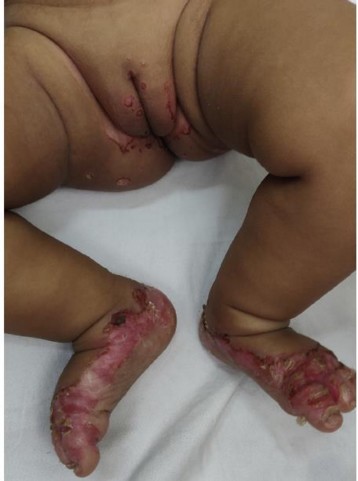(Danbolt-Closs syndrome)
Estimated incidence of 2/1.106. Skin disease caused by the malabsorption of zinc. The congenital form is caused by the autosomal recessive transmission of a mutation of the SLC39A4 gene (8q24.3) coding for a transporter protein of zinc (the Zip4 transporter) that is needed for the transcellular absorption of zinc in the duodenal and jejunal enterocytes. However, a small fraction of zinc is absorbed at the paracellular level, without the help of Zip4.
Onset:
- in the 4-10 first weeks of life of the non-breastfed infants,
- at the time of weaning for the previously breastfed infants, as cow's milk contains more zinc-binding phytates, preventing zinc absorption.
A rare form exists in breastfed infants (born at term or prematurely) if the level of Zn in breast milk is too low (maternal heterozygous mutation of the SLC30A2 gene).
Clinical presentation: eczema-like, pink scaly patches that can become pustular, blistery, psoriasiform or crusty. Lesions are usually located at the extremities and around the body orifices, typically the anogenital region. If left untreated, the skin lesions can become erosive and lead to secondary infections with Staphylococcus and Candida. Frequent symptoms include diarrhea, generalized alopecia and Beau-Reil lines on the nails. However, the triad of perorifical dermatitis, diarrhea and alopecia is present in only 20 % of cases.
Paronychia, conjunctivitis, blepharitis and erythema of the oral mucous membranes are sometimes observed. If Zn deficiency is severe and chronic: growth retardation, intellectual deficit, photophobia, hypogueusia, anemia, and pubertal delay.
Diagnosis: low plasma zinc concentrations and low levels of serum alkaline phosphatase. Molecular genetics screening can identify a mutation in the SLC39A4 gene that confirms the diagnosis.
Acquired causes of zinc deficiency can be due to glucagonoma, chronic liver and kidney diseases, nutritional deficiencies, chronic inflammatory bowel disease, AIDS, severe burn and hyperhidrosis in hot climates.
Treatment
Zinc supplementation leads to the disappearance of symptoms, but this treatment is for life and relapses may occur. Initial doses of 5-10 mg/kg/day of elemental zinc are recommended, followed by maintenance doses of 1-2 mg/kg/day, orally. Zinc sulphate is the best tolerated preparation in most cases, but it can also be given in the form of acetate, gluconate and amino acid chelates. Zinc and copper levels should be monitored regularly. Doses should be increased during growth periods, such as adolescence and during pregnancy, when relapses may occur.

Anesthetic implications:
fragile skin: difficult securing of venous lines and endotracheal tube;check volemia, proteinemia and blood electrolytes if chronic diarrhea; decreased protein fixation in case of hypoalbuminemia.
References :
- Bierings M, Clayton P, Houwen RHJ.
Disorders in the transport of copper, ion, magnesium, manganese, selenium and zinc.
Ch 38 in Inborn Metabolic Diseases, 5th edition, Saudubray, van den Berghe, Walter, Springer 2012, p 535-51.
- Kumar S, Thakur V, Choudhary R, Vinay K.
Acrodermatitis enteropathica.
J Pediatr 2020 ; 220 : 258-9.
Updated: June 2020